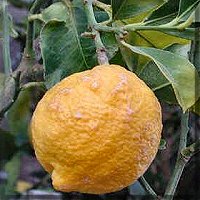
Citrus Limonum

Citrus Limonum
Pharmacology - The typical composition of lemon oil contains alpha-pinene, camphene, beta-pinene, sabinene, myrcene, alpha-terpinene, linalool, beta-bisabolene, limonene, trans-alpha-bergamotene, nerol as well as neral. It has antimicrobial, antiseptic, astringent, bactericidal, cicatrisant, depurative, diaphoretic, diuretic, febrifuge, haemostatic, rubefacient, tonic as well as vermifuge therapeutic properties on the skin. It contains a bitter principle, and yields, by expression or distillation, an essential oil, which is much used for its flavor. Both this and the rind itself are recognized in the Pharmacopoeias. When the white, spongy portion of the rind is boiled in water, and the decoction evaporated, crystals are deposited of a substance called hesperidin. This is a glucoside, and has the formula C22H26O12, and is decomposed by diluted acids into hesperetin, C16H14O6, and glucose, C6H12O6. It turns dingy black when gently warmed with alcoholic solution of ferric chloride. It is bitter, but as it is found most largely in. the spongy and comparatively tasteless part of the rind, it may be doubted whether it is entitled to be considered as the active bitter principle. Lemon peel yields its virtues to water, wine, and alcohol. E. G. Clayton (An., xix, 134) calls attention to the distinction between lemon peel and orange peel when moistened by strong hydrochloric acid. Orange peel under these circumstances changes in color from a yellow to a rich dark green color, while lemon peel retains its hue or assumes a dingy yellowish-brown tint. Citrus-limonum seed in combination with an ethyl-acetate fraction encourages anti-fertility activity, the mechanism of action was found to be the action of an anti-zygotic agent.
Constituents - Lemon Peel yields its virtues to alcohol, water, or wine. It contains an essential oil and a bitter principle. Crystals of the glucoside Hesperidin are deposited by the evaporation of the white pulpy portion boiled in water. Diluted acids decompose it into Hesperitin and glucose.
The oil is not very active, and is used chiefly for flavouring.
Medicinal Uses - Studies show that the essential oil counters a wide range of viral and bacterial infections and increases immune system activity by stimulating the production of the white corpuscles that fight infection. It is most often used in massage oil or as an aromatherapy steam. The massage oil also relieves lymph glands congested from infection and reduces bloating, and some say that it promotes weight loss. It also reduces inflammation and works particularly well at relaxing stiff muscles.
Undiluted, lemon oil, like lavender oil, may be directly applied to insect bites to take away itching and avoid swelling. The juice and peel of the Lemon are widely used as a domestic seasoning. It is very nutritious, being high in vitamins A, B, and C. In Spain and other European countries, lemon is something of a 'cure-all', especially with regard to infectious illness. It was used for fever, such as malaria and typhoid, and used specifically for scurvy on English ships at sea. Taken internally, the juice is considered invaluable for acidic disorders, such as arthritis and rheumatism, and of great benefit in dysentery and liver congestion.Lemon is best known medicinally throughout the world as a remedy that relieves fevers, sore throat, coughs, and indigestion.
Preparation and Dosages - Fresh juice (for rheumatism), 4 to 6 fluid ounces. Oil, B.P., 3 to 5 minims. Juice, B.P., 1/2 to 4 drachms.
Contraindications - It is therefore recommended that no product containing lemon oil should be applied before sun tanning, as it could cause dermal irritation.